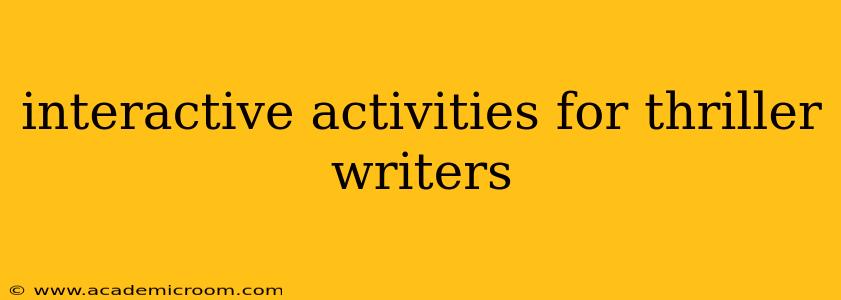Thriller writing demands more than just a gripping plot; it needs to engage the reader on a visceral level, keeping them on the edge of their seats. Interactive activities can be invaluable tools for thriller writers, helping to hone crucial skills and develop fresh perspectives. This post explores a range of activities designed to boost your thriller writing prowess, fostering creativity and sharpening your ability to craft truly suspenseful narratives.
What are the benefits of interactive writing exercises?
Interactive writing exercises offer several key advantages for thriller writers:
- Enhanced Creativity: Stepping outside your comfort zone and engaging in unconventional activities can spark new ideas and plot twists you might not have considered otherwise.
- Improved Character Development: Interactive exercises often force you to confront character motivations and behaviors in new and unexpected ways.
- Heightened Suspense and Tension: By actively experiencing the process of suspense creation, you'll develop a keener understanding of how to build tension in your writing.
- Strengthened Plot Structure: Activities focused on plot development can reveal weaknesses and help you craft a more compelling and intricate narrative.
- Improved World-Building: Immersive exercises can enhance your ability to create believable and richly detailed settings that amplify the thriller's impact.
Interactive Activities to Elevate Your Thriller Writing
Here are some interactive activities designed to push your thriller writing to the next level:
1. The "What If...?" Scenario Generator
This activity focuses on plot development and unexpected twists. Start with a basic premise for your thriller (e.g., a detective investigating a seemingly straightforward murder). Then, use a random word generator or a brainstorming session to generate a series of "what if" scenarios. For instance:
- What if the victim wasn't who they appeared to be?
- What if a seemingly unrelated event suddenly becomes crucial to the investigation?
- What if the detective discovers a hidden connection between seemingly unrelated characters?
Exploring these "what ifs" can lead to unexpected plot twists and deepen the complexity of your narrative.
2. Character Swap Challenge
This exercise enhances character development. Take two established characters from your thriller (perhaps the protagonist and antagonist) and swap their personalities, motivations, and backstories. How does this change the dynamics of the story? What new conflicts arise? This forces you to think critically about your characters' inherent traits and how those traits shape their actions and relationships within the narrative.
3. Sensory Detail Brainstorming
Thriller writing is all about immersion. This activity focuses on creating vivid descriptions. Choose a key scene from your thriller. Then, brainstorm a list of sensory details for that scene – what sounds, smells, tastes, textures, and sights would be present? The goal is to create a scene that's not just read, but experienced.
4. The "Reverse Engineering" Plot Twist
This activity helps you understand the mechanics of a compelling twist. Start with a shocking plot twist you want to include in your thriller. Then, work backward to develop the events leading up to that twist. What clues, red herrings, and foreshadowing can you weave into the narrative to make the twist both surprising and believable?
5. Collaborative Writing Exercise
This is great for fostering creativity and exploring different perspectives. Team up with another writer (or even a group) and collaboratively write a short thriller scene. Each person contributes a paragraph or section, building upon the previous contributions. This collaborative approach can spark unexpected ideas and fresh perspectives.
How to Incorporate These Activities into Your Writing Process
These interactive activities are best used in conjunction with your established writing routine. They aren't meant to replace your core writing process but rather to supplement it, providing fresh inspiration and sharpening your skills. Set aside dedicated time for these exercises, allowing yourself to freely explore ideas without the pressure of producing polished prose. The goal is to generate ideas and refine your understanding of thriller writing techniques, which you can then integrate into your main project.
By consistently engaging in these interactive activities, you'll significantly enhance your ability to craft gripping, suspenseful, and memorable thrillers. Remember that the process is just as important as the product – embrace the experimentation and enjoy the journey of pushing your creative boundaries.
